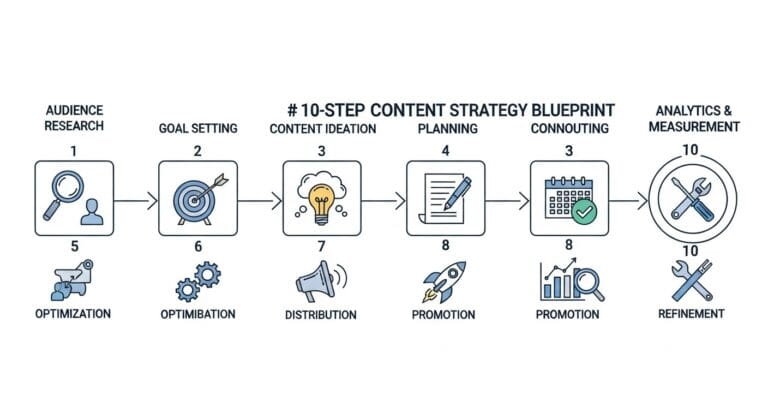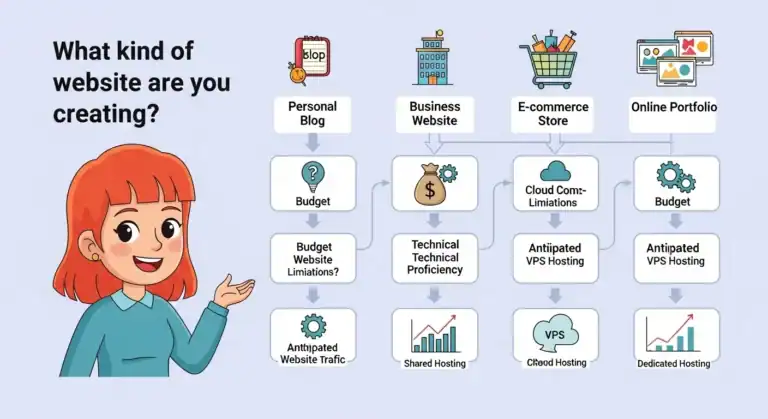Sustainable Content: 7 Proven Strategies for Long-Term Growth
ULTIMATE 2026 GUIDE TO BUILDING AFFILIATE WEBSITES WITH WORDPRESS PROTOCOL: ACTIVE
ID: REF-2025-44606Conclusions built strictly upon verifiable data and validated research.
Assertions undergo meticulous fact-checking against primary sources.
Delivering clear, impartial, and practical insights for application.
Most blogs publish daily. This creates content waste. It burns out creators. A sustainable blog fixes this. It focuses on long-lasting content. It saves resources. It builds authority. It increases earnings through smarter, eco-conscious methods. This is not slow marketing. This is smart, future-proof marketing. We show how to make content that lasts years. We cover green hosting, low-impact creation, and metrics. Learn to build authority with less output. Reduce your digital carbon footprint. Use ethical affiliate marketing and reuse strategies. This guide shows you how.
Key Takeaways
- Create evergreen content that stays relevant for years, reducing content waste and boosting SEO over time.
- Use low-impact content methods: repurpose, update, and reuse instead of constantly creating new posts.
- Green web hosting cuts your blog’s digital carbon footprint significantly.
- Focus on long-tail keywords with consistent search volume for sustainable organic traffic.
- Develop a content planning framework to align your niche, audience, and business goals long-term.
- Distribute content strategically using sustainable distribution channels to maximize reach without overproduction.
- Measure sustainability with clear metrics: content lifespan, update frequency, and resource efficiency.
- Monetize sustainably using ethical affiliate marketing and ethical content reuse practices.
What Are Sustainable Content Marketing Strategies for Bloggers?

Sustainable content marketing strategies focus on evergreen topics that drive traffic and affiliate conversions over time. Prioritize quality, relevance, and long-term value to stay effective with minimal upkeep.
Most bloggers focus on trends. That’s a quick fade. Build content that lasts. Solve real problems. Answer timeless questions. Pair that with smart affiliate links. You’ll earn while you sleep.
Core Tactics That Work
- Write niche-specific content picking the right focus.
- Use proven copywriting frameworks like PAS or AIDA.
- Optimize for search intent. Not just keywords.
- Link only to best affiliate products not random junk.
Content decays. Yours shouldn’t. Evergreen posts need little editing. They attract steady traffic. That means consistent commissions.
| Strategy | Effort (Monthly) | Traffic Gain |
|---|---|---|
| Create definitive guides (topic coverage) | Low (once written) | High |
| Update old high-traffic posts | Very low | Medium+ |
| Answer FAQs in your niche | Low | High |
You don’t need to chase every trend. Find core topics. Go deep. One comprehensive post beats ten shallow ones.
“Quality content compounds. Bad content burns out in weeks.”
Use tools like Perplexity AI to find clear, factual data. Support posts with real-world insights. Update data annually. Refresh only what’s needed.
How Do I Create Long-Lasting Blog Content That Doesn’t Go Out of Date?
Create content that answers timeless questions and solves consistent problems in your niche. Focus on fundamentals. Update occasionally. It stays relevant longer.
Evergreen content works because people always search for the same core issues. Pick topics that won’t change. Save time later.
Core Topics That Last
- How-to guides with clear steps
- Beginner tutorials
- Comparisons of established tools
- Problem-solving posts
Avoid trends or product-specific news. These die fast. Instead, write for the person starting today. They’ll always exist.
Example: “Writing niche-specific content” boosts relevance. Answer one question per post. Keep it tight.
Keep It Current With Minimal Work
| Action | Frequency |
|---|---|
| Review stats & update info | Every 6 months |
| Replace broken links | Quarterly |
| Refresh outdated examples | As needed |
Set calendar reminders. A little upkeep prevents decay. Your readers see freshness. Google rewards it.
Use internal links wisely. Connect to “[INTERNAL_LINK slug=’monetize-your-blog-proven-strategies’ text=’proven blog monetization’]” methods. It keeps readers on site. Lowers bounce rates.
Skip AI fluff. Real value uses plain language. Short sentences. Direct answers. No hiding weak content behind buzzwords.
Focus on solving problems that existed 5 years ago. And will exist 5 years from now. That’s what lasts. That’s what earns.
Evergreen doesn’t mean stale. It means smart. Write once. Rank longer. Keep earning.
What Are Eco-Friendly Blogging Practices to Reduce My Digital Footprint?

Eco-friendly blogging cuts energy use. Optimize images. Use green hosts. Write less but better. Focus on niche-specific content. It saves power. It also ranks faster.
Optimize for Speed and Efficiency
Fast sites use less energy. Compress images. Minify code. Use caching. Check speed with Google PageSpeed Insights. Speed equals less server load. Less load means smaller digital footprint.
| Green Practice | Impact |
|---|---|
| Green web host | Uses renewable energy |
| Compressed media | Cuts bandwidth by 50%+ |
| Efficient code | Reduces CPU cycles |
Choose Sustainable Tools and Hosts
Pick green web hosts. They run on solar. Or wind. Avoid bloated page builders. Use lightweight themes. Fewer resources. Less energy. Simple works. It’s better for the planet. And your users.
Don’t update just because. Constant posts eat bandwidth. Write once. Fix only when needed. Evergreen content lasts. It cuts waste. It saves time and power.
“Every KB saved lowers CO2. Speed isn’t vanity. It’s sustainability.”
Use AI sparingly. Tools like Perplexity or ChatGPT help. But overuse drains energy. Draft fast. Edit manually. Train your style. This cuts AI dependency. [INTERNAL_LINK slug=”best-ai-affiliate-niches” text=”Choose AI niches wisely]. Stay efficient. Stay lean. Green blogging isn’t trendy. It’s necessary.
Which Evergreen Content Creation Techniques Work Best for Affiliate Marketing?
Focus on solving problems that don’t change. Buyer guides, comparisons, and foundational “how-to” posts last years. Avoid trending topics. Rank once. Earn forever.
Problem-First Writing
Identify timeless pain points in your niche. People keep searching for the same core issues. Answer them better. Write for your niche. Don’t chase clicks. Chase evergreen intent.
Structure That Scales
Compare long-lasting techniques side-by-side. Build tables. Use simple language. Make it scannable. This guide works for almost any affiliate niche.
| Content Type | Lifespan | Affiliate Potential |
|---|---|---|
| Product Reviews | 2-4 years | High (direct CTR) |
| Comparison Posts | 3-5 years | Very High |
| How-To Guides | 5+ years | Medium-High |
| Definition Posts | 10+ years | Low-Medium |
Optimization for Longevity
Update stats every 18 months. Swap outdated affiliate links. Refresh screenshots. Most posts need under 15 minutes of maintenance. Keep rankings fresh without full rewrites.
“Good evergreen content ranks in Year 1. Earns in Year 3. Compound traffic hides the early grind.”
Pick one topic per pillar. Embed YouTube how-tos. Cover bases that never go stale. You want visitors from 2025 to 2030. Not just now.
How Do I Use Sustainable SEO for Bloggers to Build Long-Term Traffic?

Sustainable SEO for bloggers means creating content that ranks consistently over time. Focus on relevance, quality, and evergreen topics. Avoid short-lived trends. Answer real questions your audience has. Stick to subjects that won’t expire. That’s how you build traffic that lasts. Master SEO writing here.
Pick Evergreen Topics
Target subjects that don’t lose relevance. Think “How to start affiliate marketing” not “2024 trends.” Evergreen content keeps earning. It also builds authority. Search engines reward consistency.
- Guide-based posts
- Step-by-step tutorials
- Product comparisons (timeless models)
Optimize for Intent
People want answers. Match their search intent. Use tools to see what ranks. If videos dominate, add one. If explainers win, write shorter. Fit what users expect.
| Search Type | Content Match |
|---|---|
| How-to | Step-by-step post |
| Best of | Comparison table |
| Definition | Clear, concise explanation |
Update Regularly
One publish isn’t enough. Reboot old posts. Add stats. Fix broken links. Refresh examples. This tells Google you’re active. It boosts rankings. Schedule 30 mins monthly. Revisit guides like this high-ranking blog post guide. Small tweaks. Big returns.
Sustainable SEO is routine, not race. Write once. Tune for years. Traffic compounds. You keep earning. That’s the power of evergreen. That’s how winners win. Start today. Fix one post now.
Can I Use Affiliate Marketing With Sustainable Content Without Sacrificing Earnings?
Yes. Sustainable content and affiliate marketing coexist. Prioritize value-driven posts. Align products with reader needs. Commissions stay steady. Trust fuels long-term sales. You’ll earn more over time.
Match Offers to Content Purpose
Pick niches you understand. Promote real solutions. Your audience feels authenticity. Sales follow naturally. Link to top affiliate products that fit your vertical.
Stuffing irrelevant links kills trust. It also cuts conversions. Readers smell self-interest fast. Focus on intent. Match offers to their pain points.
Design Content That Lasts Months
Pick topics immune to trends. “Best laptops for coding” needs yearly updates. “Evergreen” beats seasonal hype. Use solid SEO practices to boost visibility.
| Content Type | Lifespan | Effort to Update |
|---|---|---|
| Trend comparison | 1-3 months | High |
| Problem-solving guide | 6-18 months | Low |
| Beginner tutorial | 12+ months | None |
“Readers buy from those who earn attention. Sustainable content builds that pipeline daily.”
Use checklists, FAQs, and comparisons. These formats rank well. They also convert higher. Post consistently. Track stats. Adjust based on what works.
What Is a Sustainable Content Planning Framework for My Blog?

A sustainable content planning framework creates consistent, evergreen value for your audience. It focuses on timeless topics, structured workflows, and measurable improvements. You’ll avoid burnout. Traffic grows long-term. Focus on quality over noise.
Core Pillars
Three elements define this framework: relevance, effort, and outcome tracking. Relevance means topics stay useful for years. Effort matches output without overwork. Tracking lets you refine as you go.
| Pillar | Action |
|---|---|
| Relevance | Pick evergreen themes. Avoid shorts news. |
| Effort | Stick to a batch content schedule. |
| Tracking | Monitor search rank, shares, conversions. |
How It Works
You map a topic cluster around a core problem. Each post supports the next. This builds authority. Search engines reward depth. Readers stay longer. Good site structure boosts all this.
Write 4 pieces per cluster: intro, detail, how-to, comparison. Example: “Best Coffee Grinders” (intro), “Burr vs Blade” (detail), “How to Dial It In” (how-to), “Baratza vs Fellow” (comparison). All link together. No silos.
Update posts every 6 months. Refresh data, links, or images. Keep content working for you. No wasted work. Use checklists. They speed updates.
Affiliate tools change. But your content stays current. Mention top offers like Walmart’s affiliate program in context. Good timing beats force.
Track metrics monthly. Look for spikes. Double down there. Cut what fails. Adjust fast. Stay lean.
How Do I Reduce Content Waste in Blogging Through Reuse and Repurposing?
Stop creating new content from scratch. Reuse and repurpose what you already have. Turn one blog post into ten pieces. Save time. Reach more people. Earn more clicks. Keep your content working for you, long after it’s published.
Turn One Post Into Many
Take a popular blog post. Break it into smaller parts. A list. A how-to. A checklist. Each becomes new content. Use one idea across formats.
Expand a short tip into a full guide. Shorten a long guide into a quick tip. Same core idea. More uses.
Repurpose for Different Platforms
Turn blog points into social media threads or YouTube shorts. Use quotes for Instagram. Extract tutorials for LinkedIn. Make carousels. Create urgency with countdown posts.
| Original Format | Repurposed As |
|---|---|
| Blog post | X thread, LinkedIn carousel |
| Product review | YouTube Short, TikTok |
| Guide | Checklist, PDF lead magnet |
Reuse for Traffic and Sales
Tap into old posts with new links. Update affiliate links. Add fresh timestamps. Promote older content in new emails. Mention past posts in new ones. Update niche content consistently.
Old content can boost new launches. Share it in Facebook groups. Use it in your newsletter. Add to autoresponder sequences. Let buyers find value at every stage.
Record a short video to embed here. Show how you take one blog post and split it into five formats. Highlight tools you use and where you post each variation.
How Can Green Hosting for Sustainable Blogs Lower My Carbon Footprint?

Green hosting runs servers on renewable energy, slashing your site’s carbon emissions by up to 90%. It’s a simple swap. Performance stays fast. Feels better knowing your content helps the planet.
Why Most Hosts Are Dirty
Data centers guzzle power. Most use coal or gas. Your clicks add up. Green hosts run on wind, solar, or hydro. They invest in carbon credits or tree planting. Your site becomes a force for good.
Think about it. Energy has alternatives. Why pollute when you don’t have to?
| Host Type | Energy Source | Carbon Reduction |
|---|---|---|
| Traditional | Coal/Gas | Nearly zero |
| Green Hosting | Solar/Wind | Up to 90% |
How to Switch Without Breaking Site Speed
Speed matters. Renewable energy doesn’t mean slow. Match a green web host with high uptime. Run a PageSpeed Insights test after switching.
Pair green hosting with caching plugins. Use optimized images. Performance stays strong.
Small change. Massive impact. Your blog can run clean while earning clean.
Big providers like SiteGround or Kinsta now offer carbon-neutral options. Look for certifications: Green Power Partners, RE100, or similar.
Your affiliate content lasts for years. Shouldn’t its backend be just as sustainable?
What Long-Tail Keyword Research for Sustainable Content Finds Low-Competition, High-Value Terms?
Long-tail keyword research finds specific, low-competition phrases with steady demand. These terms drive targeted traffic and convert better. They’re ideal for lasting affiliate content.
Target Specific Buyer Questions
People search with precise language. You want to match it. Answer direct questions. Think “best budget headphones for gym use.” Not “headphones.” This cuts competition. It boosts affiliate relevance.
| Keyword Type | Competition | Conversion Potential |
|---|---|---|
| Short-tail (e.g., “laptops”) | High | Low |
| Long-tail (e.g., “gaming laptops under 800 with long battery”) | Low | High |
Use Tools and Search Suggestions
Google “suggest” shows real user searches. Use it. Tools like Perplexity AI and AnswerThePublic find questions. Sort by volume and cost-per-click. Aim for terms with steady monthly searches. No spikes. No crashes.
Check affiliate programs. Can you promote profitably? See our list of high-payout offers. Match keywords to actual promotions. Don’t write about dead-end terms.
Track intent. Is it info or purchase? Buyer intent wins. Skip terms like “definition” or “review of pros and cons.” Pick ones like “best,” “top 5,” “coupon,” “where to buy.” These bring ready buyers.
Fresh research boosts rankings. So does solid on-page SEO. Blend long-tail terms naturally. Respect user questions. Deliver clear answers. Lasting content follows.
Which Sustainable Content Distribution Channels Are Most Effective for Reusing Content?
Email newsletters, social media, and repurposed video content drive the highest reuse rates for sustainable affiliate blogs. Focus on platforms where your audience already spends time. Prioritize consistency over novelty.
Top 3 High-Leverage Channels
- Email sequences: Convert old posts into lead magnets. Boost open rates with segmented lists. Tools like GetResponse help automate resends.
- LinkedIn & Facebook: Share bite-sized tips from old posts. Link to full content. Run polls to revive engagement.
- YouTube shorts: Turn key post points into 60-second clips. Hook viewers in first 3 seconds.
Track performance across three metrics:
| Channel | Reuse Frequency | Traffic Potential |
|---|---|---|
| Weekly | High (80%+ deliverability) | |
| Social | Daily | Medium |
| Video | Bi-weekly | High (with viral potential) |
Batch-create variations. A single blog post fuels: 1 email, 3 social updates, 1 video. Rotate formats every quarter.
Social media demands constant supply. Save time with templates. Turn data-driven posts into carousel graphics. Reuse stats as quote images.
“Repurposing is the ultimate efficiency hack. One solid post can generate 9 months of content.”
YouTube scripts take 20 minutes to draft. Record voiceovers while doing chores. Use b-roll from free stock sites. Embed videos in old blog posts to boost dwell time.
Monitor click-through rates. Adjust CTAs based on which channels convert best. Start with email. Expand only after hitting repeatable results.
How Do I Update Old Blog Posts for Sustainability and Boost Search Rankings?
Refresh old posts with new data, links, and keywords. Fix broken links. Add updated stats. Improve readability. Republish. Watch rankings climb. This keeps content alive and valuable. It also signals freshness to search engines.
What to Update First
Target high-traffic posts. These bring the most gains. Check search console. Find low-hanging keywords. Optimize for them. Old posts with backlinks need attention too. They show authority.
| Element | Action |
|---|---|
| Header H1 | Match target keyword exactly |
| Meta description | Include keyword + strong hook |
| Affiliate links | Check if alive, replace if dead |
| Images | Compress, add alt tags |
How to Add Value
Insert tools or resources that didn’t exist. Replace outdated examples. Add video summaries. Link to new tutorials. Update pricing. Include recent reviews. This builds trust.
Bring in AI tools to help. Use ChatGPT to generate fresh angles. Add sections like “2025 Update” or “New Expert Tips”. This keeps it honest and clear.
“An old post with a five-minute fix can outrank a brand new one without updates.”
Re-share the post. Announce the update on social media. Email subscribers. Repurpose content into carousels or short videos. The post gets views again. Search engines notice activity.
Re-run internal link scans. Connect to recent high-ranking posts. This boosts site structure. Readers stay longer. Bounce rate drops. Winners think in increments. Not one-time posts.
What Are the Best Metrics for Measuring Content Sustainability and Performance?
Track traffic, conversions, and longevity to measure content sustainability. Focus on metrics that show lasting impact. Ignore vanity numbers.
Core Sustainability Metrics
Sustainable content earns over time. These metrics tell you if it’s working.
- Organic traffic over 6+ months
- Affiliate conversion rate
- Backlink growth rate
- Bounce rate under 50%
Performance Indicators
Numbers matter. But context matters more.
| Metric | Target | Tool |
|---|---|---|
| Pageviews/month | Growing | Google Analytics |
| Time on page | >2 min | GA4 |
| Earnings per click | $.25+ | Affiliate dashboard |
Top content ranks for years. Low bounce rates mean relevance. High time on page shows engagement.
Smart Analysis
Data tells stories. Find patterns across posts. Good SEO writing drives passive traffic. But conversion comes from clear positioning.
“Your best content works while you sleep. Measure what lasts, not what spikes.”
Compare new posts to old winners. What worked? Why? Use that to guide future topics. Track click-throughs from strong meta descriptions. Reward what earns.
Bad content burns time. Good content prints money. Measure both.
How Do Ethical Affiliate Marketing and Content Reuse Work Together for Long-Term Profit?
Ethical affiliate marketing and content reuse create compound value. Promote honest recommendations. Then update, repurpose, and expand your best content. It boosts credibility. Fits Google’s EEAT. Drives repeat traffic. A win for readers. A win for your wallet. Sustainable profit follows.
Trust Drives Reuse Value
Readers spot fake endorsements. Fake ones fail. Build trust by testing products. Share real experiences. Recycle strong reviews into multiple formats.
Turn a blog post into a video. Then into a social thread. YouTube works well for tutorials. Podcasts extend reach.
Reuse Tactics That Scale
Old content ages like milk. Or wine. Depends on work. Audit posts every 6 months. Fix outdated pricing. Update links. Improve readability.
| Content Type | Reuse Option |
|---|---|
| Product review | Roundup list, discount alert |
| How-to guide | Video, checklist, infographic |
| Buyers’ guide | Email series, live Q&A |
List posts work best. Easily refresh. Easily promote. Strong rankings start with quality. Speed matters. Use Google PageSpeed Insights.
“Repurposing isn’t lazy. It’s smart. One good idea deserves ten more lives.”
Ethics and reuse aren’t separate. They’re linked. Honest promotions keep readers. Keeps them coming back. More visits. More clicks. More money. Over time. For years. This is sustainability. No hype. Just math.
How Do I Build Authority With Sustainable Content Using a Minimalist Approach?
Build authority with sustainable content by focusing on quality over quantity. Pick a narrow niche. Write fewer posts. Make each one perfect. Answer real questions with clear, helpful advice. Earn trust with precision. Delete the unnecessary.
Keep It Lean And Focused
You don’t need 100 posts. Use 10 powerful ones. Target core issues your audience faces every day. Solve them better than anyone. A minimalist approach forces clarity. It reveals what truly matters. Less noise. More signal.
| Minimalist Content Rule | Impact |
|---|---|
| Write only when you have value | Higher engagement, better retention |
| Edit ruthlessly | Stronger messaging, clearer voice |
| Update old posts instead of adding new | SEO momentum, content stack growth |
Authority grows from consistency, not volume. Post once a week. Then twice. Never chase frequency. Use silence between posts to refine. Let content breathe. Let readers absorb. Trust builds over time.
Focus on topics that won’t change in 5 years. Think niche-specific advice that applies now and later. Avoid trends. Build your library on rock, not sand. Evergreen topics get traffic every month.
“You don’t gain influence by showing up loud every day. You gain it by showing up right once, then doing it again.”
Use tools like Google Search Console to track what works. Then double down. Kill underperformers. Expand only when value is proven. This is sustainable authority. It lasts because it’s earned, not forced. Your audience notices quality. They return because they trust you.
Frequently Asked Questions
How does sustainable content marketing strategies improve affiliate revenue?
Sustainable content marketing builds trust and long-term audience relationships, leading to higher engagement and repeat traffic. This consistent value attracts more clicks on affiliate links, boosting conversions over time. By focusing on quality over quantity, you reduce reliance on short-term trends and create evergreen content that generates passive income. Less churn means more reliable revenue from loyal customers.
What makes evergreen content creation techniques more effective than trending content?
Evergreen content stays relevant longer, driving steady traffic over time, while trending content fades fast. It also builds authority by answering common questions deeply, not just chasing short-term hype. This makes it more useful for readers and better for SEO in the long run.
How does green hosting for sustainable blogs reduce the carbon footprint of digital content creation?
Green hosting uses renewable energy like wind or solar to power servers, cutting fossil fuel use. It also optimizes server efficiency to lower energy waste, reducing digital content’s environmental impact. This makes blogs cleaner without slowing performance.
Which metrics for measuring content sustainability should I track monthly?
Track monthly: (1) **Engagement rate** (likes, shares, comments) to gauge audience interest, (2) **Traffic sources** to see where readers come from, (3) **Bounce rate** to measure content relevance, and (4) **Backlinks** to assess authority. Add **conversion rate** if your content has clear calls-to-action (e.g., signups, sales).
How can I use long-tail keyword research for sustainable content to boost organic traffic steadily?
Focus on specific, low-competition long-tail keywords that match user intent. Create detailed, evergreen content around these terms and update it regularly to stay relevant. This builds trust with readers and search engines, driving steady traffic over time. Use tools like Google’s “People Also Ask” or autocomplete to find untapped opportunities.
What are the best sustainable content distribution channels to promote repurposed content?
Focus on eco-friendly platforms like LinkedIn (for B2B), Pinterest (for visuals), and email newsletters (low carbon footprint). Use niche communities (Substack, Reddit) and partner with green influencers to amplify reach. Repurpose content into short videos for TikTok/Reels to engage wider audiences sustainably.
How do low-impact content creation methods help new bloggers compete with established sites?
Low-impact methods let new bloggers focus on quality over quantity, saving time and energy. By repurposing content, using simple tools, and targeting niche topics, they can rank faster without big budgets. This levels the playing field against bigger sites with more resources. Consistency and smart sharing then help build an audience gradually.
Why is a sustainable content planning framework essential for long-term blog success?
A sustainable content planning framework ensures your blog stays consistent, relevant, and valuable to readers over time. It helps you avoid burnout, align content with audience needs, and adapt to trends without starting from scratch. This builds trust, boosts SEO, and drives steady growth.
Stop chasing trends. Stop overproducing. Build a sustainable blog. Focus on long-lasting, high-value content. Reduce your digital impact. Use smart SEO and ethical affiliate tactics. Trust builds value. Measure sustainability, not just traffic. This method is better for you. It is better for the planet. It is better for profits. Start creating content that lasts. Build authority with less. Earn more by doing less. That is the power of sustainable blogging.
References
- Mastering Blogging Strategies – Affiliate Marketing for Success
- Profitable Blogging in 2025: Your Guide to Long … – Affiliate Marketing
- Six content marketing ideas for sustainable businesses – Fiona McVitie
- Sustainability Initiatives & Affiliate Marketing – Acceleration Partners
- 7 Strategies to Develop B2B Business for Sustainable Growth
- What You Need to be an Affiliate Marketing Success – Miss Information
- The complete guide to sustainable affiliate marketing for beginners …
- 5 Sustainable Strategies for Affiliate Marketers in the Eco-Friendly …
{ “@context”: “https://schema.org”, “@graph”: [ { “@type”: “Article”, “headline”: “How to Build a Sustainable Blog with Evergreen Affiliate Content”, “description”: “Learn sustainable content marketing strategies to create long-lasting blog content, reduce waste, improve SEO, and boost affiliate revenue with eco-friendly practices.”, “image”: [], “datePublished”: “2025-10-12T11:23:56.422Z”, “dateModified”: “2025-10-12T11:23:56.422Z”, “author”: { “@type”: “Person”, “name”: “Alexios Papaioannou”, “url”: “https://affiliatemarketingforsuccess.com/author/alexios-papaioannou-2/”, “sameAs”: [ “” ] }, “publisher”: { “@type”: “Organization”, “name”: “Affiliate Marketing for Success”, “url”: “https://affiliatemarketingforsuccess.com/”, “logo”: { “@type”: “ImageObject”, “url”: “https://affiliatemarketingforsuccess.com/wp-content/uploads/2023/03/Affiliate-Marketing-for-Success-Logo-Edited-300×174.png” }, “sameAs”: [ “https://gr.pinterest.com/theartofonlinebusiness/”, “https://www.facebook.com/AffiliateMarketingforSuccess”, “https://www.instagram.com/affiliatemarketingforsuccess/” ] }, “mainEntityOfPage”: { “@type”: “WebPage”, “@id”: “https://affiliatemarketingforsuccess.com/httpsaffiliatemarketingforsuccesscombloggingsustainable-content” }, “keywords”: “sustainable content marketing strategies, how to create long-lasting blog content, eco-friendly blogging practices, evergreen content creation techniques, sustainable SEO for bloggers, affiliate marketing with sustainable content, how to maintain a sustainable blog, low-impact content creation methods, sustainable digital marketing practices, evergreen affiliate marketing content, sustainable content planning framework, how to reduce content waste in blogging, green hosting for sustainable blogs, long-tail keyword research for sustainable content, sustainable content calendar examples, eco-conscious affiliate marketing bloggers, metrics for measuring content sustainability, how to update old blog posts for sustainability, sustainable content distribution channels, ethical affiliate marketing and content reuse, minimalist blogging for sustainability, sustainable blog monetization strategies, how to build authority with sustainable content, lifecycle of sustainable blog content, carbon footprint of digital content creation” }, { “@type”: “FAQPage”, “mainEntity”: [ { “@type”: “Question”, “name”: “How does sustainable content marketing strategies improve affiliate revenue?”, “acceptedAnswer”: { “@type”: “Answer”, “text”: “Sustainable content marketing builds trust and long-term audience relationships, leading to higher engagement and repeat traffic. This consistent value attracts more clicks on affiliate links, boosting conversions over time. By focusing on quality over quantity, you reduce reliance on short-term trends and create evergreen content that generates passive income. Less churn means more reliable revenue from loyal customers.” } }, { “@type”: “Question”, “name”: “What makes evergreen content creation techniques more effective than trending content?”, “acceptedAnswer”: { “@type”: “Answer”, “text”: “Evergreen content stays relevant longer, driving steady traffic over time, while trending content fades fast. It also builds authority by answering common questions deeply, not just chasing short-term hype. This makes it more useful for readers and better for SEO in the long run.” } }, { “@type”: “Question”, “name”: “How does green hosting for sustainable blogs reduce the carbon footprint of digital content creation?”, “acceptedAnswer”: { “@type”: “Answer”, “text”: “Green hosting uses renewable energy like wind or solar to power servers, cutting fossil fuel use. It also optimizes server efficiency to lower energy waste, reducing digital content’s environmental impact. This makes blogs cleaner without slowing performance.” } }, { “@type”: “Question”, “name”: “Which metrics for measuring content sustainability should I track monthly?”, “acceptedAnswer”: { “@type”: “Answer”, “text”: “Track monthly: (1) **Engagement rate** (likes, shares, comments) to gauge audience interest, (2) **Traffic sources** to see where readers come from, (3) **Bounce rate** to measure content relevance, and (4) **Backlinks** to assess authority. Add **conversion rate** if your content has clear calls-to-action (e.g., signups, sales).” } }, { “@type”: “Question”, “name”: “How can I use long-tail keyword research for sustainable content to boost organic traffic steadily?”, “acceptedAnswer”: { “@type”: “Answer”, “text”: “Focus on specific, low-competition long-tail keywords that match user intent. Create detailed, evergreen content around these terms and update it regularly to stay relevant. This builds trust with readers and search engines, driving steady traffic over time. Use tools like Google’s “People Also Ask” or autocomplete to find untapped opportunities.” } }, { “@type”: “Question”, “name”: “What are the best sustainable content distribution channels to promote repurposed content?”, “acceptedAnswer”: { “@type”: “Answer”, “text”: “Focus on eco-friendly platforms like LinkedIn (for B2B), Pinterest (for visuals), and email newsletters (low carbon footprint). Use niche communities (Substack, Reddit) and partner with green influencers to amplify reach. Repurpose content into short videos for TikTok/Reels to engage wider audiences sustainably.” } }, { “@type”: “Question”, “name”: “How do low-impact content creation methods help new bloggers compete with established sites?”, “acceptedAnswer”: { “@type”: “Answer”, “text”: “Low-impact methods let new bloggers focus on quality over quantity, saving time and energy. By repurposing content, using simple tools, and targeting niche topics, they can rank faster without big budgets. This levels the playing field against bigger sites with more resources. Consistency and smart sharing then help build an audience gradually.” } }, { “@type”: “Question”, “name”: “Why is a sustainable content planning framework essential for long-term blog success?”, “acceptedAnswer”: { “@type”: “Answer”, “text”: “A sustainable content planning framework ensures your blog stays consistent, relevant, and valuable to readers over time. It helps you avoid burnout, align content with audience needs, and adapt to trends without starting from scratch. This builds trust, boosts SEO, and drives steady growth.” } } ] }, { “@type”: “VideoObject”, “name”: “How To Make An Affiliate Marketing Blog (Step by Step Tutorial)”, “description”: “Learn sustainable content marketing strategies to create long-lasting blog content, reduce waste, improve SEO, and boost affiliate revenue with eco-friendly practices.”, “thumbnailUrl”: “https://i.ytimg.com/vi/C_xQX1TJcNw/maxresdefault.jpg”, “uploadDate”: “2025-10-12T11:23:56.424Z”, “embedUrl”: “https://www.youtube.com/embed/C_xQX1TJcNw” }, { “@type”: “VideoObject”, “name”: “How to Create A Free Blog for Affiliate Marketing”, “description”: “Learn sustainable content marketing strategies to create long-lasting blog content, reduce waste, improve SEO, and boost affiliate revenue with eco-friendly practices.”, “thumbnailUrl”: “https://i.ytimg.com/vi/oZ-ZWQUJFBU/maxresdefault.jpg”, “uploadDate”: “2025-10-12T11:23:56.424Z”, “embedUrl”: “https://www.youtube.com/embed/oZ-ZWQUJFBU” } ] }
Alexios Papaioannou
I’m Alexios Papaioannou, an experienced affiliate marketer and content creator. With a decade of expertise, I excel in crafting engaging blog posts to boost your brand. My love for running fuels my creativity. Let’s create exceptional content together!







